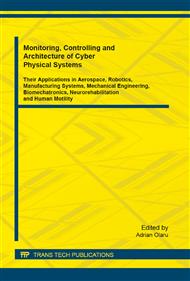[1]
C. Alexandru, The kinematic optimization of the multi-link suspension mechanisms used for the rear axle of the motor vehicles. Proceedings of the Romanian Academy, 10: 3 (2009) 244-253.
Google Scholar
[2]
Y. Papegay, J.P. Merlet, D. Daney, Exact kinematics analysis of car's suspension mechanisms using symbolic computation and interval analysis. Mechanism and Machine Theory, 40: 4 (2005), 395-413.
DOI: 10.1016/j.mechmachtheory.2003.07.003
Google Scholar
[3]
M. Raghavan, Suspension design for linear toe curves: a case study in mechanism synthesis, Journal of Mechanical Design, 126: 2 (2004) 278-282.
DOI: 10.1115/1.1667933
Google Scholar
[4]
E. Rocca, R. Russo, A feasibility study on elastokinematic parameter identification for a multilink suspension. Journal of Automobile Engineering, 216: 2 (2002) 153-160.
DOI: 10.1243/0954407021528995
Google Scholar
[5]
R. Sancibrian, P. Garcia, F. Viadero, A. Fernandez, A. De-Juan, Kinematic design of double-wishbone suspension systems using a multiobjective optimisation approach. Vehicle System Dynamics, 48: 7 (2010) 793-813.
DOI: 10.1080/00423110903156574
Google Scholar
[6]
P.A. Simionescu, D. Beale, Synthesis and analysis of the five-link rear suspension system used in automobile. Mechanism and Machine Theory, 37: 9 (2002) 815-832.
DOI: 10.1016/s0094-114x(02)00037-x
Google Scholar
[7]
J.S. Zhao, F. Chu, Z.J. Feng, S. Zhao, Synthesis of a rear wheel suspension mechanism with pure rectilinear motion, Journal of Mechanical Design 131: 10 (2009) 71-79.
DOI: 10.1115/1.3179153
Google Scholar
[8]
H. Min, Kinematic design sensitivity analysis of suspension systems using direct differentiation. KSAE, 5: 1 (1997) 38-48.
Google Scholar
[9]
C. Alexandru, Software platform for analyzing and optimizing the mechanical systems, in: Proc. of the 10th International Symposium on Science of Mechanisms and Machine, 2009, pp.665-677.
DOI: 10.1007/978-90-481-3522-6_56
Google Scholar
[10]
V. Ţoţu, C. Alexandru, Multi-criteria kinematic optimization of a front multi-link suspension mechanism using DOE screening and regression model, Applied Mechanics and Materials 332 (2013) 351-356.
DOI: 10.4028/www.scientific.net/amm.332.351
Google Scholar
[11]
R. Grossman, R. Del Vecchio, Design of experiments, John Wiley & Sons, (2007).
Google Scholar
[12]
W.G. Manteiga, A.P. González, Goodness-of-fit tests for linear regression models with missing response data. Canadian Journal of Statistics, 34: 1 (2006) 149-170.
DOI: 10.1002/cjs.5550340111
Google Scholar


